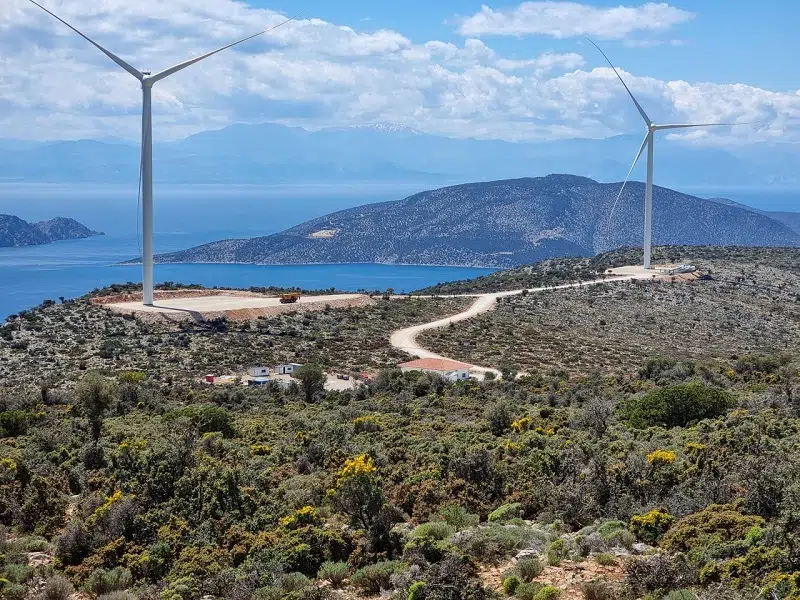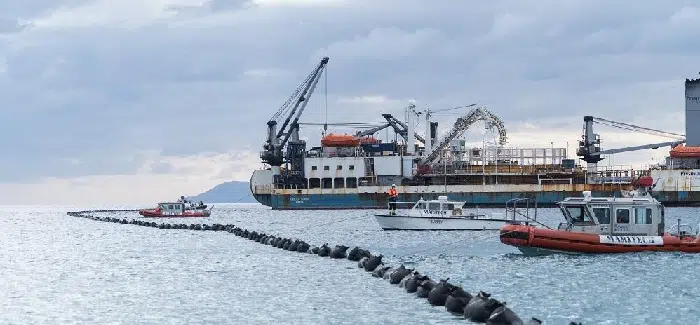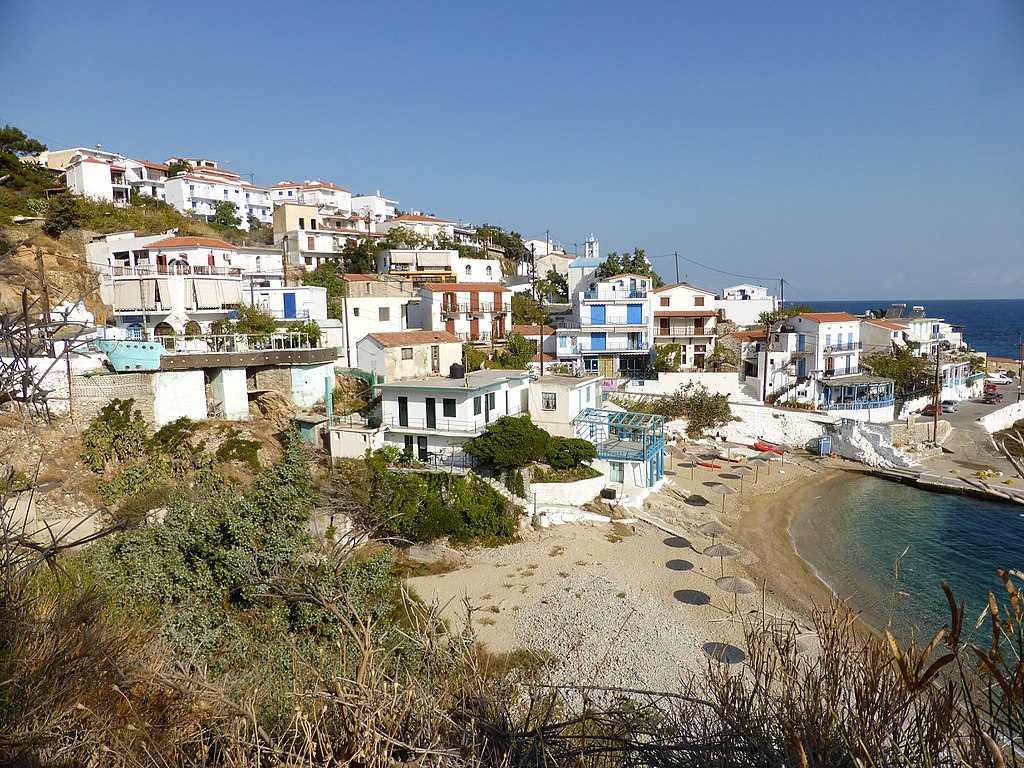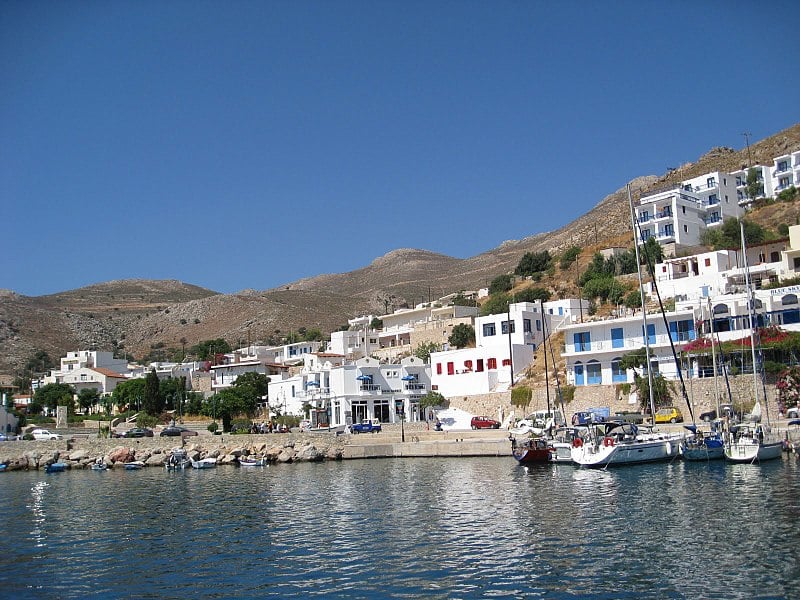
Greek islands are attracting significant investments in renewable energy. But switching to renewable energy is a challenge for islands whose grids are isolated from the mainland. There are also environmental concerns.
By Evan Bourtis
Near the coastline of Crete, winding roads lie alongside wind turbines with their three blades all pointed toward the sea. The turbines, built on the ridges of mountains where wind speeds are highest, generate electricity to power cities and remote villages across the island.
Renewable energy on Crete has boomed in the past three decades, said Dr. Yiannis Vourdoubas, an independent researcher from Chania who has published dozens of journal articles and books about environmental sustainability.
When Vourdoubas was a child on Crete, nearly all the electricity came from oil-burning generators. Then in the 1980s, he and his colleagues were among the first on Crete to promote renewable energy including wind farms, solar panels, and hydropower. They also studied how the island could produce biofuel, including from the sugar-rich fruit pods of the carob tree.
Vourdoubas went on to consult businesses that brought renewable energy to the island known for its gorges, snowcapped mountains, and remains of ancient Minoan civilizations.
“I have seen Crete change in 30-35 years and I’m very pleased. When I started, very few renewable energy technologies were used in Crete,” he said.
Crete got around 20% of its electricity on average from renewable sources in 2018 according to Hellenic Electricity Distribution Network Operator. But on Greece’s mainland, that percentage is nearly double.
Some of Greece’s best spots for producing wind and solar energy are on the islands. Despite this, the islands tend to be more reliant on fossil fuels compared to the mainland, said Dr. Eleni Zafeiratou, who studied energy modeling and planning on Greece’s island during her Ph.D. program at the University College London.
For example, on Santorini with its white-and-blue villages built on cliffs, almost all the electricity is generated from burning oil. On Mykonos, known for its relics of windmills from the 1700s used to grind wheat, little of the island’s energy comes from wind or other renewables.
Recently, companies have sought to build hundreds of wind turbines and solar panels on the Greek islands, where over 1.3 million people live and millions of tourists visit annually. Zafeiratou said these projects can help Greece to achieve its goal of fighting climate change by becoming carbon neutral by 2050.
“The Greek islands have a huge potential for installing onshore and offshore wind or solar, especially for larger islands like Rhodes and Crete. They could definitely be a driver of carbon neutrality by 2050,” Zafeiratou said.
However, groups have debated about what forms of renewable energy are best for the islands and raised concerns about islands becoming overdeveloped with wind farms.
Climate change is making Greek islands more vulnerable
As carbon emissions drive an increase in average global temperatures, Greece’s islands are becoming more vulnerable. A report from the World Wildlife Fund found that sea levels in the Mediterranean are rising because of climate change and could rise by one meter by 2100. That puts homes and tourist amenities on the islands’ waterfronts at risk of damage.
Zafeiratou, who lives in Athens and loves to travel to the islands, said she’s also concerned about climate change worsening extreme weather events. In October 2022, flooding in northern Crete killed two people in seaside villages, swept away cars, and buried homes in landslides. In August 2021, wildfires burned homes across 126,000 acres of northern Evia in one of Greece’s largest ever environmental catastrophes.
“People in Greece have become aware of climate change and the way it could impact tourism,” she said. “Extreme events are happening more often and islands are one of the most sensitive regions.

Challenges of bringing renewable energy to islands
To fight climate change, Greece is working to reduce its carbon footprint in its electricity sector. But switching to renewable energy is a challenge for islands whose grids are isolated from the mainland.
Greece’s mainland is part of an electricity grid that spans over 130,000 square kilometers, reaching into neighboring countries and into some islands near the coastline such as Evia. In 2022, the mainland and its connected islands got an average of 39% of its energy from renewable sources, setting a new record according to Greece’s Independent Power Transmission Operator (IPTO).
The massive size of the mainland’s grid allows for communities to consume energy produced in a wind turbine or solar panel thousands of kilometers away. If one part of Greece has little wind or clouds cover the sun, another part with better conditions can step up.
However, nearly 30 Greek islands or island clusters are so remote that their electricity grids aren’t connected to the mainland, including Santorini and Mykonos. Instead, these islands must generate their own electricity, often using oil-burning power plants instead of renewables. Unlike the mainland, non-interconnected islands couldn’t get renewable energy shuttled in from other regions when weather conditions don’t allow them to produce their own.
Electricity prices on non-interconnected islands is typically more than twice as expensive compared to the mainland because of the cost of importing oil, found a report from the National Technical University of Athens. Also, blackouts are common when the islands are unable to keep up with the jump in electricity demand during high tourism months.
Greece is working on a 4.3 billion Euro project to help islands to trade their oil-burning plants for cleaner energy. By 2030, Greece hopes to connect nearly all its islands to the mainland’s grid using undersea cables that cross the Aegean and beyond. The cables will not only allow islands to import energy from the mainland but to expand their own renewable energy production, Zafeiratou said. With the cables, alongside improved energy storage, islands will always have a backup energy source during times of low wind or sun.
“Right now, there are technical limitations that prohibit islands from installing renewable energy to a certain amount,” she said.
In April 2021, one of the first steps in the massive interconnection project was complete. The IPTO finished what it called the world’s longest undersea cable connecting western Crete to the Peloponnese. By next year, the IPTO wants to complete another undersea cable linking eastern Crete with Attica.
Vourdoubas said the completion of the first cable, which isn’t up-and-running yet, has already attracted companies that want to expand renewable energy on Crete. In October 2021, Athens-based Terna Energy started building two wind farms and a hydroelectric power plant at the Amari River Dam in central Crete.
“I think Crete has the ability to become carbon neutral because we have abundant renewable energy sources,” Vourdoubas said.

Concerns about overdevelopment on islands
Typically, when an island produces so much renewable energy that it can’t be used at once, it goes to waste. Once the undersea cables are complete, the energy can be sent to the mainland to power homes.
While the cables will create new energy-sharing opportunities, some groups are worried about islands becoming overcrowded with wind turbines.
Companies have proposed building hundreds of wind turbines and solar panels across the Aegean Islands and Crete after they become connected, according to a map by the Regulatory Authority for Energy (RAE).
Many islands would have enough wind turbines, not just to cover their needs, but to power homes in the mainland using the sea’s blustery winds. That’s according to Akis Papasarantis, an Athenian who professionally sails tourists around the islands.
Papasarantis said overcrowding islands with wind farms would damage natural landscapes, since constructing the turbines often involves flattening parts of mountains with dynamite and building unnecessary roads. He is concerned that plans such as building over 150 turbines on Andros and over 100 turbines on Ikaria would permanently alter these islands.
“We have to find other ways. We cannot destroy the land like this,” Papasarantis said.
Papasarantis said he co-founded the organization Movement for the Protection of the Islands to fight against these large-scale wind farms. The group believes the islands can instead use smaller-scale projects that incorporate wind, solar, and battery storage of renewable energy to become self-sufficient in their energy production. He said these projects should involve planning by the islands’ residents and reducing energy use.
Papasarantis says he knows the power of wind – Greece’s dominant form of renewable energy – very well. For decades, he’s harnessed the wind to sail across the Aegean – exploring islands with homes coated in white plaster and stony terrains with thriving ecosystems.
“I know all the islands because it’s my life. Even the most remote ones,” Papasarantis said.
In 2020, Papasarantis and another member of his organization, freelance translator Alexis Schaffner, sailed to Aegean islands to hold town hall meetings about the impact of wind projects expected to break ground later this decade. Many residents expressed concerns about the visual impact of the turbines, which are up to 200 meters high while most buildings on islands don’t exceed 10 meters.

On Ikaria, an island known for having residents with extremely long lifespans, a Greek company got a license to cover a mountain range that spans across the island with 110 wind turbines. Schaffner said the proposed project would damage Ikaria’s landscapes to generate energy for the mainland, when the island already has a small hybrid renewable energy plant that includes two wind turbines.
“Virtually the whole island is against this project, but the central government constantly ignores the local voices,” he said.
Schaffner said that on Corfu where he used to live, which is connected the mainland, a proposal to build wind turbines one of the island’s highest mountains was shut down after opposition from residents.
Schaffner also worries about the wind turbines after they break down, which typically happens after 20 years. He said the island of Andros has old wind turbines that haven’t been replaced and keep deteriorating. He is concerned that the same will happened with the 159 additional wind turbines that will be built or were recently built on Andros.
“In general, wind turbines are not replaced at the end of their life cycle, but just left standing until they fall to pieces,” he said.
Dr. Ioannis Kaldellis, a professor and renewable energy researcher at the University of West Attica, said many islands residents, including on his home of Lesvos, want to decrease their need for oil. However, residents are also worried about wind turbines making noise, creating a visual impact, and taking up land that could be used to develop tourist amenities.
“Some people are afraid that by interconnection, the islands would be an area of huge wind farms,” he said.
Best renewable sources for Greece
Schaffner said solar power seems to offer a less destructive alternative to wind power. Homes on the islands typically have roofs that are flat exposed to the sun, offering a place to install solar panels without developing land.
Schaffner said rooftop solar would allow both big cities like Athens and small villages to produce renewable energy.
“Solar panels on roofs can support the energy consumption on the building itself,” he said.
Schaffner would also like to see Greece develop geothermal energy on islands with volcanic activity, which includes Crete and many islands in the Cyclades. Currently, less than 1% of Greece’s renewable energy comes from geothermal, compared to 85% for wind and 10% for solar, shows last August’s report from the IPTO.
However, that may change. Greece granted a license to develop geothermal energy in an area that spans across the islands Milos, Kimolos, and Polyaigos. That area could produce enough geothermal energy to cover half of the Cycladic islands’ total needs, according to the Hellenic Society for the Environment and Culture.
Schaffner is impressed with how islands outside Greece, such as Iceland, have covered most of their energy needs with geothermal
Tilos’ renewable transformation

Tilos, a small, S-shaped island northwest of Rhodes, has undergone a renewable energy transformation this decade. The island went from relying on oil to producing between 50% to 100% its electricity from renewable sources, according to the European Commission.
Tilos has been recognized as one of Europe’s most sustainable islands. It placed third in a European Union-wide competition in 2021 for islands that have used renewable energy to improve quality of life.
Even during times of low wind or sun, Tilos still gets most its energy from renewable sources – but it’s not from an undersea cable linking it to the mainland. Tilos’ secret is a battery that stores energy from its solar panels and its single wind turbine located near its northwest most tip.
In October 2014, Tilos received a grant from the European Union to build Greece’s first battery station for renewable energy storage. The mayor of Tilos, Maria Kamma- Aliferi, told Greek Reporter in January 2022 that the battery has helped to make electricity cheaper and more reliable.
“Before we achieved energy self-sufficiency, black-outs were a regular phenomenon. They were occurring perhaps twice a week. We have eliminated this problem,” she said.
Tilos – an island of around 500 year-round residents with a hilltop medieval castle – historically got its energy from an oil-burning plant on the larger island of Kos. Although Kos isn’t connected
to the mainland, it provides electricity to neighboring islands through underwater cables. Now that Tilos produces its own energy, it relies less on Kos.
Residents of Tilos decided on the scale and location of the renewable energy projects, said Kaldellis, who planned the islands’ battery storage with his colleagues at the Soft Energy and Environmental Protection Lab at the University of West Attica.
Kaldellis said the renewable energy transformation on Tilos has helped to draw eco-conscious tourists.
“Touristic activity on Tilos has increased not only because they have more energy but also because people like green tourism,” he said.
Kaldellis said other islands are working to curb their carbon emissions now, instead of after they become connected to the mainland. They’re working to boost quality of life by making their energy sector more independent and are fighting climate change as a result.
Agios Efstratios in the northern Aegean is looking to become Greece’s first island to rely entirely on renewable energy year-round. The island recently got a license to install a battery station similar to the one on Tilos. Astypalaia, in the middle Aegean, is working to transition to electricity from wind and solar after the island partnered with Volkswagen to bring in electric vehicles.
“You have the option to connect the mainland or to develop your own solution,” he said.
See all the latest news from Greece and the world at Greekreporter.com. Contact our newsroom to report an update or send your story, photos and videos. Follow GR on Google News and subscribe here to our daily email!



